
C.A.T.S. and World Mythology
"I have studied many philosophers and many cats. The wisdom of cats is infinitely superior."
Hippolyte Taine
Read as Rain-Cloud, a Korat Cat living his 9th life recounts the Sacred History of C.A.T.S.
RAIN CLOUD
We have been the protagonists of myths and legends from all over the world. Some have worshipped us, some have condemned us, and today people are idolising us again, though maybe not with that fervor of the Ancient Egyptians.
By the way, you may either view the whole document, or go immediately to the part you like by clicking on one of these:
Egyptian Cats - Norwegian Goddesses - Witches and their Cats - Islam and Cats - The Legend of the Burmese Cat - The Sacred Siamese - Rain Cloud Cats - the Korat - Malaysian Cats - The Beckoning Cat, Japan - Noah'sArk - Ngariman, Australian legend - Cat Superstitions
NOTE: All these images have been taken from other pages, with the permission of the respective authors. I think it is the least I can do to link their pages. After each section, in fact, you'll find a link or two. Besides that, if you click on the images, it will send you to the page they came from.
![]()
Moments in Love by the Art of Noise
"It all started in Ancient Egypt...
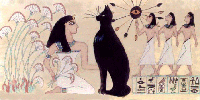 ...when the Egyptians
started identifying the lions that must have roamed in the desert
around their land with the Sun. They believed that at sunset, Ra,
the Sun God, would die and descend through the underworld in the
West, to be born again in the East, at sunrise. During the night,
therefore Ra was always in great danger, as his enemies, like the
great serpent Apophis would not hesitate to attack him.
...when the Egyptians
started identifying the lions that must have roamed in the desert
around their land with the Sun. They believed that at sunset, Ra,
the Sun God, would die and descend through the underworld in the
West, to be born again in the East, at sunrise. During the night,
therefore Ra was always in great danger, as his enemies, like the
great serpent Apophis would not hesitate to attack him.
However, the lions would look unto the setting sun, and keep its rays in their eyes, for they, like us, have eyes that reflect in the dark. With that fire burning in their eyes, the lions would go forth and kill the serpents of the night, as we were going to do afterwards, when the domestic cat was bred in the temples of the Black Land.
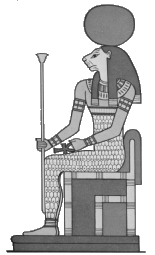 With the image of the lion in
mind, the Egyptians built the Sphinx, a huge effigy of the Sun
God, with the body of a lion and the head of a Pharaoh, and they
also worshipped the goddesses Sekhmet, who with the head of a
lion (see picture) was the goddess of war, who descended to the
earth to destroy the enemies of Ra. There was another feline
goddess, called Mafdet, who was often depicted as a civet or an
ocelot.. In an Ancient Egyptian spell which repels snakes, the
protection of Mafdet is invoked: 'O cobra, I am the flame which
shines on the brows of the Chaos-gods of the Standard of Years.
Begone from me, for I am Mafdet!'
With the image of the lion in
mind, the Egyptians built the Sphinx, a huge effigy of the Sun
God, with the body of a lion and the head of a Pharaoh, and they
also worshipped the goddesses Sekhmet, who with the head of a
lion (see picture) was the goddess of war, who descended to the
earth to destroy the enemies of Ra. There was another feline
goddess, called Mafdet, who was often depicted as a civet or an
ocelot.. In an Ancient Egyptian spell which repels snakes, the
protection of Mafdet is invoked: 'O cobra, I am the flame which
shines on the brows of the Chaos-gods of the Standard of Years.
Begone from me, for I am Mafdet!'
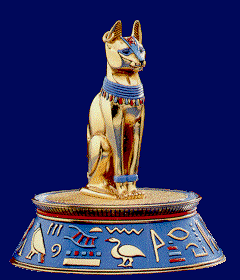 However,
the climax of our importance was on our first appearance as the
domestic cat, and in Egypt we were worshipped as incarnations of
the Goddess Bastet. Bastet was often said to be the daughter of
Ra, and she was associated with cats, those who took care of
cats, joy, pleasure, children and all things feminine. Her cult
was centred in the city of Bubastis, where, once her temple
stood. The Greek historian, Herodotus said "there is no
temple more beautiful than that of Bubastis". Besides that,
there was a necropolis where hundreds of mummified cats were
buried. She also had an annual festival, which seems to have been
one of the most popular in Egypt. She is often represented either
as a woman with a cat's head, or just as a cat.
However,
the climax of our importance was on our first appearance as the
domestic cat, and in Egypt we were worshipped as incarnations of
the Goddess Bastet. Bastet was often said to be the daughter of
Ra, and she was associated with cats, those who took care of
cats, joy, pleasure, children and all things feminine. Her cult
was centred in the city of Bubastis, where, once her temple
stood. The Greek historian, Herodotus said "there is no
temple more beautiful than that of Bubastis". Besides that,
there was a necropolis where hundreds of mummified cats were
buried. She also had an annual festival, which seems to have been
one of the most popular in Egypt. She is often represented either
as a woman with a cat's head, or just as a cat.
For women, the ideal beauty was that of a cat. Therefore, they used make-up to give their faces a mysterious cat-like look. Often children were consecrated to Bastet - a cut was made on their arm and drops of cat blood poured into it. A marble coffin of a royal cat refers to the cat contained inside it as "Lady Cat". A human who killed a cat, even accidentally, was put to death, and when a cat died, the owners used to shave off their eyebrows as a sign of mourning. You know, once they found a tomb of a prince in Egypt, one who was called Nebkephrure, or Tutankhamun as he is more often called. On a gilded shrine, in which there was the royal coffin one can still see the image of the serene Bastet, whose protection is invoked. One of the discoverers, Lord Carnarvon, had become interested in Egyptology after discovering a cat coffin.
Many of us went to foreign lands, by stowing away in Phoenician and Roman ships. From Egypt we spread to Europe and Asia, where we branch out in an infinite range of breeds. From Egypt to Rome and after that to Scandinavia to where the fertility cult of Bastet was passed on. After being with the Phoenicians some of us went to Turkey and later to Burma, China and Japan, amongst other Asian countries. There we have our own stories too. But I will speak of those later...
In the meantime, our cousins in Egypt are still highly respected, for in that land, the bond between cat and human is now eternal, with cats walking among the streets in the market place, where till today, the images of Bastet are still being offerred to tourists, as they must have been offerred once, a long time ago, to pilgrims, who would have been going to the annual celebration of Bastet!
 we were venerated alongside the
goddess Freyja, a Vanir goddess of youth, sexual love and
fertility, pretty much the Scandinavian equivalent of Aphrodite.
The day Friday is named after her (in German, in fact, it is Freitag).
Her connection with cats is this. Her personal transport was a
magnificent chariot, drawn by two large grey cats. Probably this
connection was made because of the fertility cults which passed
from Egypt (the rites of Bastet) to Scandinavia via Rome. As the
cats travelled, lore and myth travelled with them...
we were venerated alongside the
goddess Freyja, a Vanir goddess of youth, sexual love and
fertility, pretty much the Scandinavian equivalent of Aphrodite.
The day Friday is named after her (in German, in fact, it is Freitag).
Her connection with cats is this. Her personal transport was a
magnificent chariot, drawn by two large grey cats. Probably this
connection was made because of the fertility cults which passed
from Egypt (the rites of Bastet) to Scandinavia via Rome. As the
cats travelled, lore and myth travelled with them...
Want to view wonderful pictures of Freyja
and other gods and goddesses from all parts of the world click here.
For more information about Freyja, click here.
"And the witches! We must not forget those!...
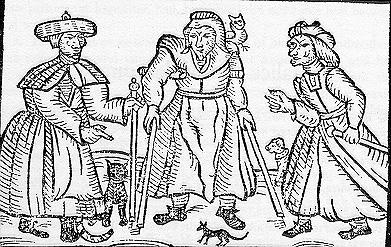 Probably a witch would have been
just an old woman or maybe even a young once, at most
superstitious (who wasn't those days?) who owned a cat. Nothing
more than that! Why were cats associated with witches??? It is
either because of our association with fertility (witches were
reputed to perform pagan rituals, especially those connected with
fertility) or maybe just because we have a bit of an impish look
about us. The Knights Templar, condemned as heretics confessed
that they renounced Christ and worshipped cats instead, in
fertility rites. Probably these are tales exaggerated under
torture, but there is some truth in the persistence of fertility
rituals and their connection with cats.
Probably a witch would have been
just an old woman or maybe even a young once, at most
superstitious (who wasn't those days?) who owned a cat. Nothing
more than that! Why were cats associated with witches??? It is
either because of our association with fertility (witches were
reputed to perform pagan rituals, especially those connected with
fertility) or maybe just because we have a bit of an impish look
about us. The Knights Templar, condemned as heretics confessed
that they renounced Christ and worshipped cats instead, in
fertility rites. Probably these are tales exaggerated under
torture, but there is some truth in the persistence of fertility
rituals and their connection with cats.
A respectable witch had to have a "familiar", or so it was called. This "familiar" was an animal companion often said to have been given to the witch by Satan, or said to be a devil in its own right. More often than not, this "familiar" was a cat, though it could have been a frog for example, and if it were a cat, it needn't have been a black cat. The cat became synonymous with Satan and Eve, the temptress. Pope Gregory IX denounced black cats as Satanic in his 1233 Papal Bull 'Vox in Rama' and this launched the extermination of many cats, and subsequently thousands of cats were burned alive in the cause of searching out the devil. Tales of these witches' cats turning into mice, dogs, bats and all sorts of creatures flourished during the Middle Ages.
Another version I heard of why black cats are often associated with witches and the Devil is this. The "blackberry" cats are often born at the end of the blackberry season, which according to legend is the time of the year in which Satan was thrown out of heaven, landing on a blackberry bush which he then defiled with his urine and spittle.
It is painful to remember how many of our number and how many of our owners died in the name of superstition! Cats used to be burned alive in wicker baskets. Their cries were said to be the cries of the devil.
Becuase of the association of black cats with witches and with the devil, they are often said to be, in modern day superstition, unlucky cats. However, my opinion on that is that they must have been lucky enough to survive the Inquisition!!!
...were considered to be very clean animals. The Prophet Mohammed is said to have kept cats himself, though no particular Islamic legend is associated with cats.
"Then there's the Sacred Cat of Burma...
The legend of the Birman takes
place in a temple built on the sides of Mount Lugh, in Burma,
where in the temple of Tsun Kyan-Kse, a Goddess whose golden
image, with blazing sapphire eyes resided in the temple itself,
the holy Kittah Mun-Ha was head monk. The God Song Hio himself
braided Mun-Ha's beard with gold. Mun-Ha always used to meditate
infront of the Goddess with the sapphire eyes. The Goddess Tsun
Kyan-Kse made sure that the Kittahs would be reborn as an animal
for the duration of a life, after which the soul would be in
Nirvana, shining with a golden halo.
Accompanying him in his meditation was Sinh, a white cat whose ears reflected the yellow of the golden Goddess and the golden beard of his master, and whose nose, tail and paws were brown like the earth on which he stood.
As the moon shone, one night, Mun-Ha entered a transcendental state which was so deep that he felt no pain when the Phoums, Siamese invaders murdered him. Sinh placed his gentle paws on the monk's robes. Facing the Goddess, Sinh's fur became gold, like the golden statue before him, and his eyes became the beautiful blue shining eyes of the Goddess. His legs, his tail, his ears and his face became a velvety rich brown. His paws, which were gently laid on his master's body became a purest white.
The Kittahs, though in a state of panic due to
the invasion, obeyed Sinh's commanding but serene look, and
closed the heavy bronze doors of the temple, thus saving it from
the invaders.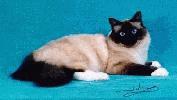
The next morning, the remaining ninety-nine cats had been similarly transformed, and thus the Birman breed has its origins. Sinh did not move from the place of his master's death, and exactly seven days incident, he died, carrying with him the soul of after the Mun-Ha, which it was his duty to present to Tsun Kyan-Kse who would reward him with Nirvana.
On that same day, the priests were arguing about who should succeed Mun-Ha. All the transformed temple cats entered the temple and in complete silence surrounded the youngest of the Kittahs, who was to succeed Mun-Ha.
Common belief says that when a priest dies, he would be reincarnated as a Birman cat before attaining heaven. Another belief, according to Major Russell Gordon is this: "But woe also to he who brings about the end of one of these marvelous beasts, even if he did not mean to. He will suffer the most cruel torments until the soul he has upset is appeased."
Want to learn more about the Birman's story? Here are two links to websites concerning the Birman, both called "The Legend of the Sacred Cat of Burma". The first one is more mystical (also see The Temple of the Sacred Cat), while the second one gives us a more scientific point of view about the Burmese cats (besides the legend, that is) and is the site from where the second image was taken. It is Pooka, the page creator's cat, photographed by Larry Johnson. A good book you may read is "The Birman Cat (The Sacred Cat of Burma)" by Vivianne Smith.
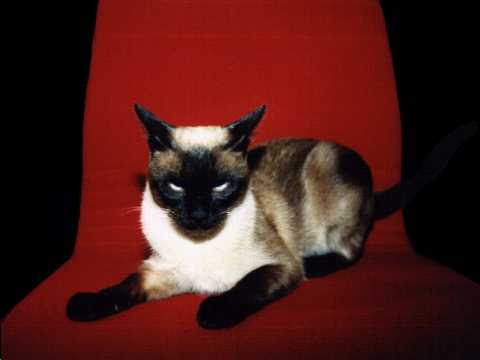 too has it's own legend. It was said
that when Siamese kings died, their souls would pass on to a
Siamese cat, so that he could be present at the coronation of the
succeeding king before attaining heaven. This cat would have been
treated as part of the Royal family, and would have resided in
the palace.
too has it's own legend. It was said
that when Siamese kings died, their souls would pass on to a
Siamese cat, so that he could be present at the coronation of the
succeeding king before attaining heaven. This cat would have been
treated as part of the Royal family, and would have resided in
the palace.
Besides that, there are some Siamese cats who have a kinked tail and who have yet another legend. They're considered auspicious in the Far East, and legend has it that this cat kinked it's tail so as to provide a safe place for the princess' rings while she was bathing. She used to slide her rings along the cat's tail, and there was no danger of them being lost, as the kinked tail prevented them from falling. Of course, if the cat ran away, it would be a different story, but if a cat is so faithful so as to kink his/her tail, I can't imagine him running away.
(Rain Cloud himself smiles at this
point. Ever seen a cat smiling?) Yet another cat myth from the
mysterious Orient is that of the Korat, a blue grey cat, like I
am. Since our colour resembles that of a rain cloud, we were
originally called Si-Suwat, meaning "grey cat". We were
later renamed by King Ramu V of Siam after the region of our
origin. I said we are Rain Cloud Cats because our colour
resembles a rain cloud. This is what a poet had to say about us:
"The hairs are smooth
with roots like clouds,
and tips like silver,
and eyes that shine
like dewdrops on a lotus leaf."
Flattering, eh? Rather unlike the royal Siamese, we are linked with the farmers, who to induce rain carry one of our kind in procession, while they themselves chant and pray to the sky gods. After the procession, the water is sprinkled on the cat's face so as to seduce rain. (I always hated this part.)
"Yet another story from the Orient...
...has its origins in Malaysia, where people believed the cat would help souls journey from Hell (in this case, the equivalent of the Christian Purgatory) to Paradise. The punishment for killing a cat was to carry and stack as many coconut tree trunks as the cat had hairs. (Talk about deforestation!)
"And after that, we'll pass on to Japan...
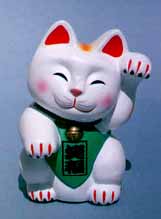 ...where we find the origins of
the Beckoning Cat, or the manekineko as he is called in
Japan. This cat, long long ago, stood in the door of the
Gotoku-ji temple and raised her paw in the traditional Japanese
beckoning gesture to a feudal lord who was passing by.
...where we find the origins of
the Beckoning Cat, or the manekineko as he is called in
Japan. This cat, long long ago, stood in the door of the
Gotoku-ji temple and raised her paw in the traditional Japanese
beckoning gesture to a feudal lord who was passing by.
The feudal lord followed the cat into the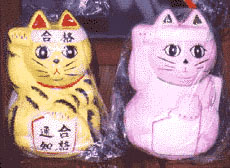 temple and instantly, a lightning bolt struck the place where the
lord had been standing. Thus the cat had saved his life. From
then on, the manekineko was considered as an incarnation
of the Goddess of Mercy.
temple and instantly, a lightning bolt struck the place where the
lord had been standing. Thus the cat had saved his life. From
then on, the manekineko was considered as an incarnation
of the Goddess of Mercy.
The Gotoku-ji Temple now houses dozens of statues of this Cat, and owners of lost or sick cats stick up prayer boards with the image of the Beckoning Cat in this temple.
In business the manekineko is said to
bring success. This is because her raised paw
beckons in customers. It also welcomes in personal happiness and
harmony. A black Beckoning Cat brings health, while a gold one,
which is quite rare, brings in riches. Beckoning Cats are often
sold as money boxes and in a house they are supposed to beckon in
good friends.
is because her raised paw
beckons in customers. It also welcomes in personal happiness and
harmony. A black Beckoning Cat brings health, while a gold one,
which is quite rare, brings in riches. Beckoning Cats are often
sold as money boxes and in a house they are supposed to beckon in
good friends.
This is the logo of Catseye Creative
Services, a web design firm,
created by Mark D. Segal. (c)1997 Michelle Klein-Hass/Catseye
Creative Services.
Click on it to go to the Catseye main homepage.
If you want to hear another version of the Beckoning Cat story
click here,
and if you want to order one, or even some other Japanese curios
click
here
...have been the subject of many folk
legends, which though not always so well established as the
Bastet and manekineko legends, are always fun to know.
According to one of these, at the time of the flood, Noah took
pairs of rats and mice too. However, the rodents multiplicated
very quickly and the Ark was, after a while, infested by rodents.
Noah consulted the lion, who as king of the beasts may have known
a solution. The lion sneezed and from his nostrils, a pair of
ready made domestic cats came out, who instantly set down to
work, having a natural instinct for being
"verminators".
Sometimes, it is said that God created the cat, but that the mouse is the Devil's work. The Devil's mouse set out to destroy all life forms by gnawing a hole in the Ark. However, God's cat saved the day by killing the mouse, and a frog crept in the hole, thus getting it's amphibian tendencies, by being in contact with water and dry wood simultaneously.
Yet another Noah's Ark cat legend is that of the Manx cat, who has no tail because it was unpunctual in its arrival to the Ark, and the careless Noah closed it's tail in the door of the Ark. Well, after all he was only human, ey?

Want to see a site about cats in Noah's Ark?
Either click on the image above or click here.
"Some even say that in the Australian Dreamtime...
..., when the ancestral spirits sang the world into existence, there was a cat-man called Ngariman. The Bagadjimbiri brothers, that is the Creator Gods of Karadjeri tradition, travelled far and wide while creating the world. One of the strange things they saw was Ngariman, the cat man, who in their eyes was so funny that they were paralysed with laughter. Ngariman was offended, and together with his relatives, killed the brothers. The Earth Goddess, Dilga was moved by this scene and from her breasts a torrent of milk flowed which drowned Ngariman and his relatives and revived the Bagadjimbiri brothers.
However Ngariman was probably not a domestic cat, as those arrived in Australia around 1785 from Britain (though some may have arrived earlier from Indonesian ships). Rather, he was probably a native Australian marsupial cat (Vasyurus Maculatus).
...concerning cats are the following: In the Ozark Mountains of Tennessee and Arkansas, a girl not knowing what to answer to a marraige proposal would take three hairs from a cat's tail (ouch!) and put them in a folded piece of paper, which she placed under her doorstep. She would answer according to whether the hairs formed an "N" or a "Y".
A cat on a grave meant that the buried person's soul was in the possession of the Devil, and if two cats were fighting on a grave, this signified the Devil and the defunct person's Guardian Angel fighting for his/her soul.
In the early 16th century, a visitor to an English home would always kiss the family cat. In Ireland, however, a black cat passing infront of you by moonlight foretells death by an epidemic.
These and many more cat
superstitions can be
found at Cat Folklore.
To go to another site about
Cats
and Mythology (amongst other things) click here.
Well, I have said all I know about C.A.T.S. and their myths. However, if you've got another story to tell me just e-mail me.
Rain Cloud.
![]()
You are cat/human no.
to have visited this site
This site has been awarded the Temple of the Sacred Cat Award
Go back to the Magic Paw - Go
back to Pio's Homepage
Cat History - Cat Myths - Cat Literature - Cat Astrology
Cat Jokes - Jerry must Die! - List your Cat
![]()
| This Mystic
Cat Ring site is owned by Katascali To join the ring, click here. Previous 5 Sites Previous Next Next 5 Sites |
![]()
Last updated 29/01/98.
© Michael Pio Deguara 1997